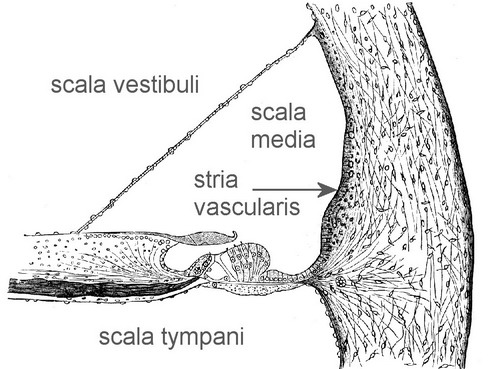Endolymph
Definition:
Endolymph is the fluid that fills the scala media of the cochlea. Hence this space is also known as endolymphatic space / Scarpa's space.
The walls surrounding the endolymphatic space are said to have occluding tight junctions between the cells obstruction ionic movements in and out of this compartment. Commonly accepted borders of this space are shown in the figure above.
This endolymphatic space extends through out the membranous labyrinth and is joined to the endolymphatic sac by the endolymphatic duct.
Site of secretion of endolymph:
It has generally been accepted that endolymph of the cochlea is produced by stria vascularis.
The cells of stria vascularis are secreting cells. Under light microscope this area can be divided into:
1. Superficial - Dark stained cells (marginal cells)
2. Basal cells - Lightly stained cells
When seen under electron microscope the marginal cells show long infoldings on its basal edge i.e. the edge farthest from the endolymph. These infoldings contain numerous mitochondria. It is here that energy consuming pumping takes place in the stria vascularis.
Composition of endolymph:
Endolymph is very unique among extracellular fluids in that it contains high concentrations of potassium and low concentrations of sodium resembling more the intracellular fluid composition. Concentration of potassium in endolymph varied from 144 - 188 mM. Concentration of sodium in endolymph varied from 0.2 - 2 mM. The endolymph has a postitive charge ranging from + 50 - +120 mV. The potentials can still be larger close to stria vascularis. This positive charge is maintained by the activity of energy consuming Na + K+ -ATPase in the marginal cells of stria vascularis. This potential is also known as endocochlear potential.
How is this endocochlear potential generated ?
The current accepted model of endolymphatic fluid potential generation is the one proposed by Wangemann and Marcus etal. This model infact relies on the complex geometrical orientation of strial spaces.
The steps include:
1. Removal of potassium from the intrastrial space by acitve pumping in the basal membranes of marginal cells.
2. This reduces the level of potassium in the intrastrial space
3. Diffusion of potassium occurs through the potassium channels between the intermediate cells and the intrastrial space.
4. This generates a diffusion potential between the intrastrial space and the intermediate cells
5. Intrastrial space becomes highly positive thus giving rise to endocochlear potential.



